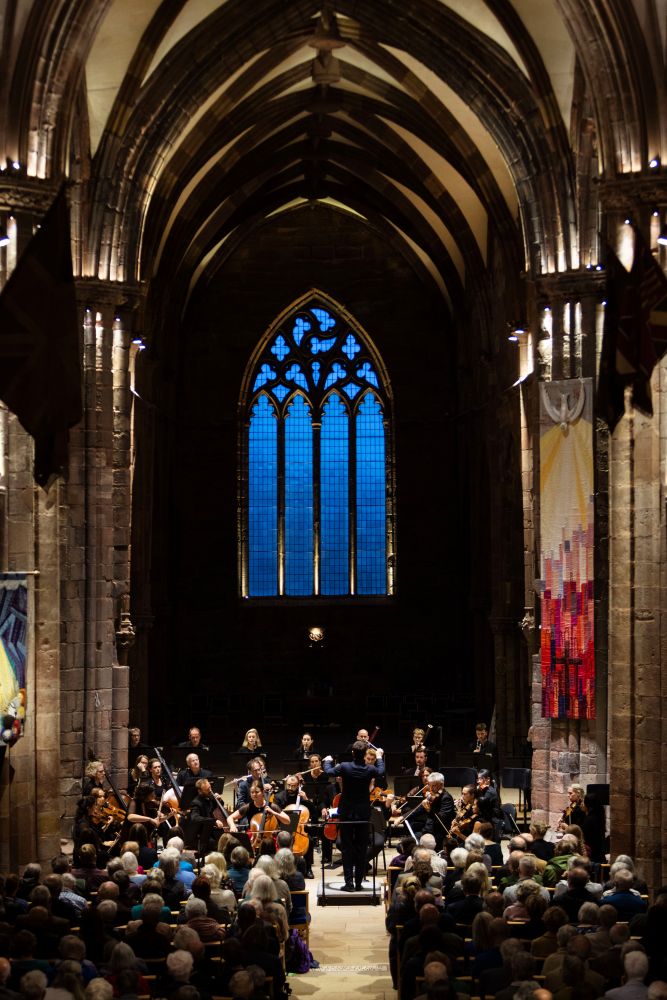Lammermuir Festival 2025, Part 2 review - from the soaringly sublime to the zoologically ridiculous | reviews, news & interviews
Lammermuir Festival 2025, Part 2 review - from the soaringly sublime to the zoologically ridiculous
Lammermuir Festival 2025, Part 2 review - from the soaringly sublime to the zoologically ridiculous
Bigger than ever, and the quality remains astonishingly high

My colleague Boyd Tonkin visited the Lammermuir Festival for the first time this year. His eyes and ears have been opened to its treasures, but some of us have been in on the secret for years. Importantly, that includes the East Lothian audiences, who have been attending the festival in bigger numbers than ever, ensuring that the festival has sold out almost every concert in its biggest venue, St Mary’s Church, Haddington, and packed out many other smaller ones, too.
The festival’s major modus operandi is to build partnerships with artists over considerable chunks of time, so as to create not only a relationship with the festival but a bond with audiences. Their Thursday evening concert in St Mary’s Haddington brought three of those partnerships into focus through Brahms’ Double Concerto. The orchestra, the Royal Northern Sinfonia, have been Lammermuir guests since way back. (In addition to all the musical benefits, it’s a practical gig for them because they can get there and back in a night from Newcastle.) The violinist, Maria Włoszczowska, is the RNS’s leader, as well as an in-demand Lammermuir Festival soloist in her own right, while the cellist, Laura van der Heijden, is the festival's artist-in-residence this year, playing several different concerts with different combinations of collaborators.
 Put all that together, along with the RNS’s Music Director, Dinis Sousa, and you have a recipe for success which was at its tastiest with the two soloists. Right from the opening, Van der Heijden’s cello line was wiry and earnest, full of urgent yearning, while Włoszczowska’s violin was ardent and passionate, as though caught on the wing. It was a pairing of contrasts that captured the concerto’s dramatic energy, yet they were capable of swapping places in an instant, such as in the first movement’s lyrical second theme, which van der Heijden played with lavish romantic ardour. They brought impressive synchronicity to the later movements, a pair of soloists that seemed to be able to read one another’s minds, whether in the slow movement’s liquid legato or the finale’s chasing runs of semiquavers.
Put all that together, along with the RNS’s Music Director, Dinis Sousa, and you have a recipe for success which was at its tastiest with the two soloists. Right from the opening, Van der Heijden’s cello line was wiry and earnest, full of urgent yearning, while Włoszczowska’s violin was ardent and passionate, as though caught on the wing. It was a pairing of contrasts that captured the concerto’s dramatic energy, yet they were capable of swapping places in an instant, such as in the first movement’s lyrical second theme, which van der Heijden played with lavish romantic ardour. They brought impressive synchronicity to the later movements, a pair of soloists that seemed to be able to read one another’s minds, whether in the slow movement’s liquid legato or the finale’s chasing runs of semiquavers.
The orchestra sounded terrific, too, particularly the strings in the flowing, mahogany warmth of Brahms’ slow movement, and they showed their versatility in a reading of Mozart’s Don Giovanni Overture where the vibratoless strings were as lean as a 100m sprinter; in other words about as far from mahogany warmth as you could imagine. They also brought joyous energy to Mendelssohn’s Italian Symphony, and Sousa was so keen to get his hands on it that he popped the opening champagne cork before the welcome applause had even finished. The first movement moved with sunny buoyancy, with a central fugato section that was bitingly incisive. Repeatedly, Sousa showed remarkably attention to detail, pointing up this phrase or that in a way that shone fresh light on it. The strings played with minimal vibrato in the funeral procession of the second movement, for example, but with lashings of vibrato in the Minuet, and their final Saltarello was thrillingly precise yet with plenty of ebb and flow, bringing out surprising turns of colour and pace.
Van der Heiden was back as a collaborator on Saturday night, playing with the Maxwell Quartet as the “other” cello for Schubert’s String Quintet. She helped bring a delicious level of luxury richness to their sound, something you could spot right from the first bars when the cello swaps in for the first violin in the repeat of the opening statement. The five managed to capture perfectly the acoustic of the lovely 15th century church at Whitekirk, and they played Schubert’s piece with a gorgeous, honeyed tone, the pair of cellos sounding like a rich burgundy that balanced the two violins. They played the slow movement with refreshing briskness, turning it into a fresh walk in nature rather than an introverted wallow, and this made its stormy central section even more violent, giving way to what felt like stunned stammering before the return of the opening music.
The Maxwells have made a name for playing Scottish traditional music as well as the core classics, and they opened their concert with some Gallic Psalm chants from the Western Isles which then dissolved into a jig and reel that might have just escaped from the pub up the road. They then brought sensitivity to a raw, intimate arrangement of Byrd’s Ave Verum Corpus whose stark lines of spiritual searching seemed to serve as a natural curtain-raiser to Edmund Finnis’ String Quartet No. 1. Its wandering lines of music seemed to unfurl like tendrils in this hushed setting, and the Maxwells negotiated its exposed open spaces with stylish confidence and spiritual depth.
Like all great festivals, the Lammermuir Festival can easily make the jump from the sublime to the ridiculous, and this year we got the sublimely ridiculous on Saturday afternoon in a concert from the NYCOS (National Youth Choir of Scotland) National Girls Choir. Consisting of 12-16 year olds, and directed with focus by Christopher Bell, the choir sang light-hearted music on an animal theme, including Sally Beamish’s Three Cat Songs and Gwyn Arch’s arrangement of the Carnival of the Animals where the choir sings Saints-Saëns’ tunes while the piano fills in the rest. The lyrics aren’t always a beneficial addition, and I could have lived without Roger McGough’s poetry being interpolated between each number. Nevertheless, it was all good fun, and enormously engaging for the young singers who approached it with impressive professionalism, first-rate tuning, and excellent diction throughout.
Share this article
The future of Arts Journalism
You can stop theartsdesk.com closing!
We urgently need financing to survive. Our fundraising drive has thus far raised £49,000 but we need to reach £100,000 or we will be forced to close. Please contribute here: https://gofund.me/c3f6033d
And if you can forward this information to anyone who might assist, we’d be grateful.

Subscribe to theartsdesk.com
Thank you for continuing to read our work on theartsdesk.com. For unlimited access to every article in its entirety, including our archive of more than 15,000 pieces, we're asking for £5 per month or £40 per year. We feel it's a very good deal, and hope you do too.
To take a subscription now simply click here.
And if you're looking for that extra gift for a friend or family member, why not treat them to a theartsdesk.com gift subscription?
more Classical music
 Lammermuir Festival 2025, Part 2 review - from the soaringly sublime to the zoologically ridiculous
Bigger than ever, and the quality remains astonishingly high
Lammermuir Festival 2025, Part 2 review - from the soaringly sublime to the zoologically ridiculous
Bigger than ever, and the quality remains astonishingly high
 BBC Proms: Ehnes, Sinfonia of London, Wilson review - aspects of love
Sensuous Ravel, and bittersweet Bernstein, on an amorous evening
BBC Proms: Ehnes, Sinfonia of London, Wilson review - aspects of love
Sensuous Ravel, and bittersweet Bernstein, on an amorous evening
 Presteigne Festival 2025 review - new music is centre stage in the Welsh Marches
Music by 30 living composers, with Eleanor Alberga topping the bill
Presteigne Festival 2025 review - new music is centre stage in the Welsh Marches
Music by 30 living composers, with Eleanor Alberga topping the bill
 Lammermuir Festival 2025 review - music with soul from the heart of East Lothian
Baroque splendour, and chamber-ensemble drama, amid history-haunted lands
Lammermuir Festival 2025 review - music with soul from the heart of East Lothian
Baroque splendour, and chamber-ensemble drama, amid history-haunted lands
 BBC Proms: Steinbacher, RPO, Petrenko / Sternath, BBCSO, Oramo review - double-bill mixed bag
Young pianist shines in Grieg but Bliss’s portentous cantata disappoints
BBC Proms: Steinbacher, RPO, Petrenko / Sternath, BBCSO, Oramo review - double-bill mixed bag
Young pianist shines in Grieg but Bliss’s portentous cantata disappoints
 theartsdesk at the Lahti Sibelius Festival - early epics by the Finnish master in context
Finnish heroes meet their Austro-German counterparts in breathtaking interpretations
theartsdesk at the Lahti Sibelius Festival - early epics by the Finnish master in context
Finnish heroes meet their Austro-German counterparts in breathtaking interpretations
 Classical CDs: Sleigh rides, pancakes and cigars
Two big boxes, plus new music for brass and a pair of clarinet concertos
Classical CDs: Sleigh rides, pancakes and cigars
Two big boxes, plus new music for brass and a pair of clarinet concertos
 Waley-Cohen, Manchester Camerata, Pether, Whitworth Art Gallery, Manchester review - premiere of no ordinary violin concerto
Images of maternal care inspired by Hepworth and played in a gallery setting
Waley-Cohen, Manchester Camerata, Pether, Whitworth Art Gallery, Manchester review - premiere of no ordinary violin concerto
Images of maternal care inspired by Hepworth and played in a gallery setting
 BBC Proms: Barruk, Norwegian Chamber Orchestra, Kuusisto review - vague incantations, precise laments
First-half mix of Sámi songs and string things falters, but Shostakovich scours the soul
BBC Proms: Barruk, Norwegian Chamber Orchestra, Kuusisto review - vague incantations, precise laments
First-half mix of Sámi songs and string things falters, but Shostakovich scours the soul
 BBC Proms: Alexander’s Feast, Irish Baroque Orchestra, Whelan review - rapturous Handel fills the space
Pure joy, with a touch of introspection, from a great ensemble and three superb soloists
BBC Proms: Alexander’s Feast, Irish Baroque Orchestra, Whelan review - rapturous Handel fills the space
Pure joy, with a touch of introspection, from a great ensemble and three superb soloists
 BBC Proms: Moore, LSO, Bancroft review - the freshness of morning wind and brass
English concert band music...and an outlier
BBC Proms: Moore, LSO, Bancroft review - the freshness of morning wind and brass
English concert band music...and an outlier
 Willis-Sørensen, Ukrainian Freedom Orchestra, Wilson, Cadogan Hall review - romantic resilience
Passion, and polish, from Kyiv's musical warriors
Willis-Sørensen, Ukrainian Freedom Orchestra, Wilson, Cadogan Hall review - romantic resilience
Passion, and polish, from Kyiv's musical warriors

Add comment